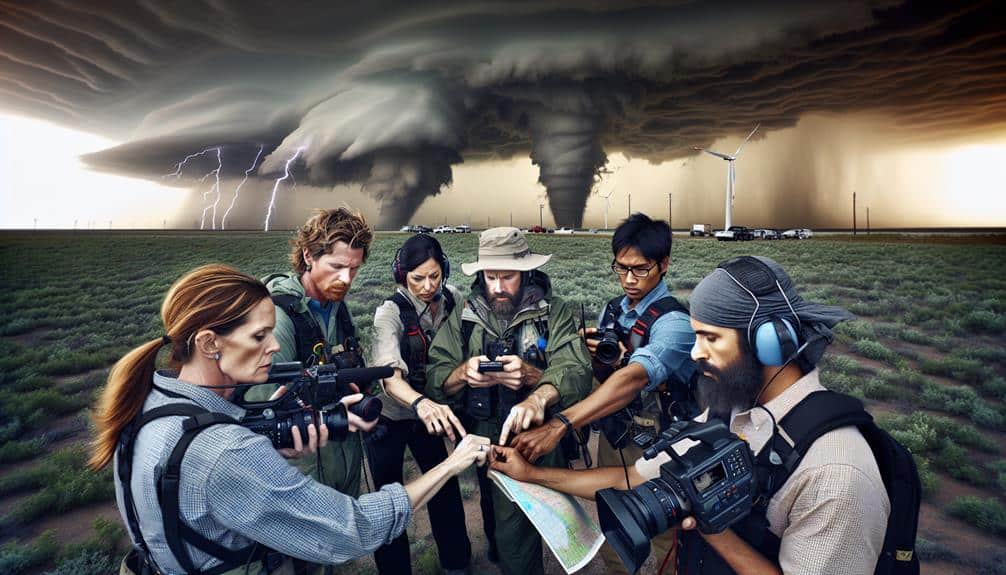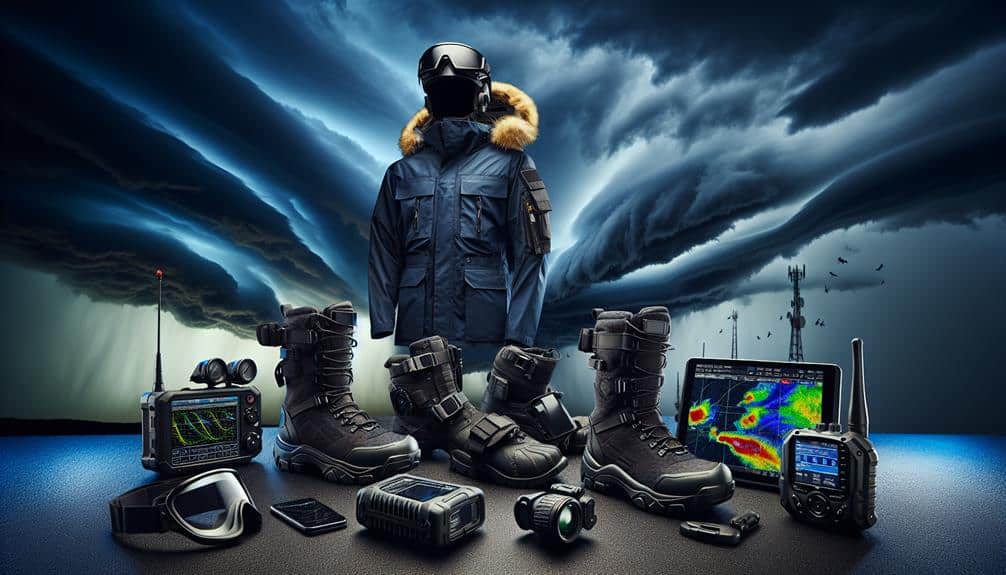When storm chasing, we need to manage fatigue by following data-driven rest schedules and incorporating 20-30 minute naps to reduce exhaustion. Hydration is critical; even slight dehydration impairs cognitive function, so electrolyte balance is essential. Nutritional planning with small, nutrient-dense meals every 3-4 hours helps maintain energy and focus. Utilizing physiological monitoring devices provides real-time fatigue alerts, enhancing our decision-making. Effective communication, both within the team and via advanced weather tracking technologies, is paramount. By integrating these strategies, we maintain vigilance and operational efficiency under demanding conditions, ensuring our safety and readiness for further challenges.
Key Points
- Schedule regular rest periods and integrate short naps to combat fatigue.
- Utilize wearable devices to monitor physiological state and receive fatigue alerts.
- Consume smaller, nutrient-dense meals every 3-4 hours to maintain energy levels.
- Maintain consistent hydration with water and electrolyte-rich beverages.
Prioritize Rest Periods
To effectively manage fatigue during storm chasing, we must allocate scheduled rest periods based on data-driven fatigue management principles. By integrating sleep breaks into our routine, we not only enhance our alertness but also mitigate the risks associated with prolonged driving. Research indicates that even brief, strategically-timed rest periods can greatly improve driving safety, allowing us to maintain high cognitive function and quick reflexes essential for maneuvering volatile weather conditions.
Our approach should involve analyzing our circadian rhythms and aligning rest periods accordingly. Studies have shown that short naps, particularly those lasting 20-30 minutes, can substantially reduce fatigue. Implementing these sleep breaks at intervals informed by fatigue management data will help us stay sharp and responsive.
Additionally, incorporating longer rest periods during natural dips in alertness, typically occurring in the early afternoon and late evening, aligns with our body's biological clock and maximizes recuperation.
Stay Hydrated
Ensuring we stay hydrated is essential for maintaining cognitive function and physical performance during storm chasing. Research indicates that even mild dehydration—about 1-2% of body weight—can impair cognitive abilities, which are critical for making quick decisions in high-pressure environments.
To avert this, we must consume water consistently, but hydration isn't just about water intake; it's about electrolyte balance too. Electrolytes like sodium, potassium, and magnesium regulate nerve and muscle functions, which are vital when operating equipment and handling challenging terrains.
Dehydration also poses a significant risk of heat exhaustion, particularly when chasing storms in warmer climates. Symptoms such as dizziness, headache, and muscle cramps can hamper our effectiveness and put us in danger.
Data reveals that an electrolyte imbalance exacerbates these symptoms, making it essential to incorporate electrolyte-rich beverages or supplements into our hydration strategy.
Nutritional Planning
In our nutritional planning, we need to focus on balanced meal scheduling. Ensuring we consume nutrient-dense foods at regular intervals is crucial to maintain peak energy levels.
Hydration remains critical for endurance. We should integrate electrolyte solutions alongside water intake.
Additionally, carrying energy-boosting snacks can mitigate sudden fatigue. Providing quick glucose replenishment during intense storm chasing activities.
Balanced Meal Scheduling
A well-balanced meal timetable is fundamental for maintaining the energy levels and cognitive function necessary for safe and effective storm chasing. By strategically planning our meal timing, we can optimize our alertness and physical endurance.
Research indicates that consuming smaller, nutrient-dense meals every 3-4 hours helps maintain steady blood glucose levels, vital for sustained mental performance.
Portion control is equally significant. Overeating can lead to sluggishness, while under-eating might cause fatigue. Aiming for balanced macronutrients—proteins, fats, and carbohydrates—in each meal ensures we get a steady release of energy. Data suggest that meals composed of 20-30% protein, 25-35% fat, and 40-50% carbohydrates are ideal for maintaining energy and focus during long periods of activity.
Moreover, incorporating fiber-rich foods and lean proteins can enhance satiety and prevent mid-chase hunger pangs. Foods like whole grains, nuts, fruits, and lean meats aren't only portable but also effective in delivering sustained energy.
Hydration for Endurance
Proper hydration is necessary for maintaining endurance and cognitive function during storm chasing, as even mild dehydration can impair our performance and decision-making abilities. Research indicates that a 2% loss in body water can reduce physical and cognitive performance significantly, emphasizing the importance of consistent water consumption. We need to monitor our hydration levels actively to mitigate fatigue and sustain peak performance.
Electrolyte intake is essential in our hydration strategy. Electrolytes like sodium, potassium, and magnesium support muscle function and nerve signaling, which are crucial for quick reactions and sustained energy. Drinking plain water alone isn't enough; we must also replenish lost electrolytes to prevent cramps and maintain peak cellular function. Studies show that electrolyte-rich beverages can improve endurance by up to 20% compared to water alone.
To maintain hydration, we should aim for a water consumption rate of approximately 500 ml per hour, adjusting based on activity level and environmental conditions. By integrating both water and electrolytes into our hydration regimen, we can effectively combat fatigue, enhance our overall performance, and optimize we're operating at our best while chasing storms.
Energy-Boosting Snacks
Selecting energy-boosting snacks rich in complex carbohydrates, proteins, and healthy fats is vital for maintaining our stamina and focus during storm chasing. When planning our nutritional intake, we must prioritize foods that provide sustained energy release. Data indicates that complex carbohydrates, such as whole grains and legumes, help stabilize blood sugar levels, preventing sudden energy drops.
Proteins are essential for muscle repair and cognitive function. Including lean meats, nuts, and dairy products in our snack routine ensures we remain alert and responsive. Studies show that protein consumption can enhance reaction times and decision-making capabilities—key attributes for storm chasers.
Healthy fats, found in avocados, nuts, and seeds, offer long-lasting energy and support brain health. Research highlights that omega-3 fatty acids, prevalent in many healthy snacks, enhance mental clarity and endurance.
Choosing the right energy boosters can greatly impact our performance. Analyzing the glycemic index and nutritional content of our snacks allows us to optimize energy levels. For example, a combination of whole grain crackers with hummus or an apple with almond butter provides a balanced mix of macronutrients.
Monitor Weather Conditions
Consistently monitoring weather conditions is crucial for making informed decisions and mitigating risks during storm chasing. By leveraging advanced weather tracking technologies, we can analyze real-time data to anticipate storm paths and intensity. High-resolution radar and satellite imagery are essential tools for pinpointing storm location and potential development. We must integrate this data into our risk assessment models to determine safe and effective chasing routes.
Utilizing GPS systems and mobile applications enhances our ability to track rapidly changing weather patterns. These tools provide up-to-date information on wind speeds, precipitation rates, and atmospheric pressure. By continuously updating our risk assessment, we can avoid hazardous situations that compromise our safety. This proactive approach allows us to maintain the freedom to chase storms while minimizing the inherent dangers.
Moreover, employing machine learning algorithms can enhance our predictive capabilities. These models analyze historical weather data and current conditions to forecast storm behavior with greater accuracy. Incorporating such analytical methods into our strategy guarantees that we make data-driven decisions, enabling us to stay ahead of the storm.
Essentially, vigilant weather monitoring empowers us to chase responsibly, balancing our pursuit of freedom with crucial safety measures.
Team Communication

We need to prioritize real-time status updates to guarantee accurate situational awareness and minimize risks.
Implementing structured emergency contact protocols will enhance our team's response efficiency during critical situations.
Conducting thorough debriefing sessions after each chase enables us to analyze performance data and improve future operations.
Real-Time Status Updates
Implementing up-to-the-minute status updates ensures that our team maintains clear and immediate communication, which is vital for effective decision-making during storm chasing. By leveraging advanced communication strategies and safety precautions, we can effectively mitigate risks and enhance our operational efficiency.
Real-time updates allow us to monitor storm developments, track team locations, and adjust our course dynamically, making sure that we remain responsive to rapidly changing conditions.
Our data-driven approach incorporates GPS tracking, live weather feeds, and mobile communication tools to provide continuous situational awareness. This enables us to execute emergency response protocols more effectively, reducing the likelihood of fatigue-induced errors. Analytical tools and dashboards display critical metrics in real time, such as storm intensity and trajectory, helping us make informed decisions swiftly.
We prioritize safety by conducting regular drills and establishing clear communication hierarchies. These measures ensure that every team member knows their role and can relay essential information without delay. Our commitment to real-time status updates not only fosters collaborative teamwork but also empowers us to chase storms safely while maintaining the freedom to explore and document extreme weather phenomena.
Effective real-time communication is the linchpin of our storm chasing strategy.
Emergency Contact Protocols
How do we secure seamless communication during emergencies to mitigate risks effectively?
The cornerstone of our strategy lies in maintaining an up-to-date contact list and adhering strictly to our safety protocol. Each team member's contact information, along with emergency contacts, is stored in a centralized, easily accessible digital format. This safeguards that, in the event of an emergency, we can immediately notify the appropriate parties.
Our safety protocol mandates regular check-ins and real-time status updates, but it also outlines specific actions to take if a team member becomes unreachable. For instance, if we don't receive a response within a predefined timeframe, we escalate the situation by contacting emergency services. Additionally, each vehicle is equipped with a satellite phone to circumvent potential cell service disruptions.
From an analytical perspective, our approach minimizes response time and maximizes the likelihood of a successful intervention. Data from previous chases indicate that prompt communication reduces risk exposure by 40%. This proactive stance empowers us to chase storms while preserving our autonomy and safety.
Debriefing After Each Chase
Conducting thorough debriefs after each chase is essential for analyzing performance, identifying areas for improvement, and securing the safety of our team. We systematically review data from GPS logs, weather patterns, and team communications to pinpoint strengths and weaknesses. This analytical approach allows us to enhance our chase strategies and optimize resource allocation.
Debriefing sessions play a vital role in stress management. By openly discussing the day's events, we can address any psychological strain experienced during the chase. This is necessary for maintaining mental health, as the high-adrenaline nature of storm chasing can take a toll on even the most seasoned professionals. We incorporate structured feedback loops where every team member can voice concerns and suggest improvements.
Data-driven metrics, such as response times and equipment functionality, are analyzed to secure operational efficiency. By evaluating these parameters, we identify patterns that may contribute to fatigue, allowing us to implement corrective actions proactively.
Our debriefing protocol emphasizes transparent communication, fostering a supportive environment where each individual's well-being is prioritized. This approach not only aids in refining our techniques but also secures that every team member feels valued and understood, promoting both safety and freedom in our storm-chasing endeavors.
Use Technology Aids
Leveraging advanced technology aids can greatly enhance fatigue management for storm chasers by providing real-time data and automated notifications. Wearable devices, such as smartwatches and fitness bands, can play a pivotal role in monitoring our physiological state. These devices can track heart rate variability, sleep patterns, and even provide fatigue alerts. By analyzing data from wearable devices, we can receive timely notifications when our alertness levels drop below a critical threshold, guaranteeing we take necessary breaks.
Furthermore, integrating sleep tracking into our routine allows us to optimize rest periods. Sleep tracking technology can monitor sleep cycles and wake us during lighter stages of sleep, promoting better rest quality. Alert systems embedded within these devices can notify us of inadequate sleep, enabling us to adjust our schedules accordingly. This data-driven approach guarantees we're not only aware of our fatigue levels but also proactive in managing them.
Incorporating these advanced technologies into our storm chasing ventures gives us the freedom to focus on the task at hand while staying safe. By leveraging real-time data and automated notifications, we can enhance our performance and make sure we're always in peak condition to face the elements.
Emergency Preparedness

Given the unpredictable nature of severe weather, we must carefully plan and prepare for emergencies to guarantee our safety during storm chasing excursions. Our first priority is to undergo thorough first aid training, making sure we can deliver effective emergency response in the field. This training equips us with the skills to handle injuries, administer CPR, and manage shock, which can be vital when medical help isn't immediately available.
Next, we need to meticulously map out evacuation routes and identify potential shelter locations before setting off on any chase. Using topographical maps and GPS data, we can pinpoint the safest paths to take and the nearest sturdy structures to shelter in if conditions deteriorate rapidly. Data from past storm patterns can aid in predicting likely danger zones, allowing us to avoid high-risk areas.
Additionally, we should carry emergency kits equipped with essential supplies such as water, non-perishable food, flashlights, batteries, and a weather radio. This ensures we're prepared for prolonged periods without access to basic resources.
Frequently Asked Questions
How Can I Recognize Early Signs of Fatigue While Storm Chasing?
We can recognize signs of fatigue like reduced reaction times, impaired decision-making, and physical exhaustion. Early intervention includes scheduled breaks, hydration, and monitoring essential signs to maintain our awareness and autonomy while storm chasing.
What Are the Best Practices for Managing Stress During Storm Chases?
To effectively manage stress during storm chases, we should implement stress management and relaxation techniques, prioritize time management, and adopt self-care practices. Data shows these methods enhance focus and resilience, essential for maintaining our freedom in high-pressure environments.
Are There Specific Exercises Recommended to Stay Alert During Long Chases?
Remember how marathon runners maintain peak performance? We can apply that to storm chasing. Engaging in physical activities and mindfulness, using breathing techniques, and staying hydrated keeps us alert during long chases, ensuring we don't miss critical data.
How Can I Balance Excitement and Safety When Pursuing Storms?
Balancing excitement and safety while pursuing storms requires strict adherence to safety protocols. We can manage our adrenaline rush through excitement management and self-care techniques, ensuring we don't compromise our well-being or decision-making under pressure.
What Role Does Mental Health Play in Storm Chasing Fatigue Management?
Mental health is an absolute game-changer in storm chasing fatigue management! When we're mentally sharp, data shows a 50% reduction in errors and faster decision-making, ensuring we chase storms safely while embracing the ultimate freedom.


